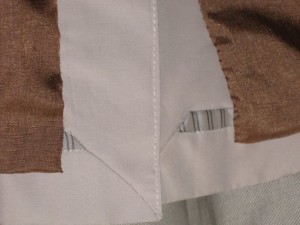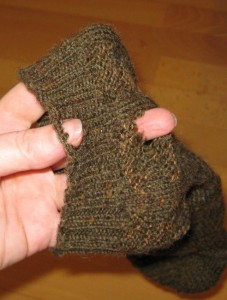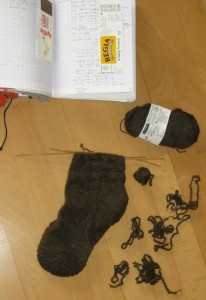Against obsolescence
Die Hersteller allerlei Konsumgüter lassen sich ja immer was einfallen, damit wir Sachen wegwerfen müssen, die eigentlich noch fast gut sind. Aber nicht mit mir!
Producers often try to construct their articles in a way that we have to throw them away even though they are mostly good. But I am not willing to play that game!
 Hier haben wir eine Tasche, die erst einige Jahre alt ist und die mein Mann nur selten nutzt. Sie sieht eigentlich noch ganz gut aus.
Hier haben wir eine Tasche, die erst einige Jahre alt ist und die mein Mann nur selten nutzt. Sie sieht eigentlich noch ganz gut aus.
Und ist das weitgehend auch noch.
Here is a purse that is only some years old and that is only rarley used by DH. All in all it looks still fine.
And also is mostly fine.
 Bis man die Polsterung des Gurtes anschaut. Von der löst sich da was ekliges.
Bis man die Polsterung des Gurtes anschaut. Von der löst sich da was ekliges.
Until you look the padding of the strap, there is some stuff coming off.
Das an sich wäre auch nicht schlimm, ohne das geht es eigentlich gut. Nur… das Zeug was abgeht, das hinterläßt üble Flecken auf der Kleidung. Die teilweise selbst die Waschmaschine überlebt. (Was allerdings erst auffällt, seit mein Mann nicht nur eine schwarze, sondern auch eine helle Jacke hat. 🙂 )
That would not be a big problem, because whatever it is you don’t really need it. Only… the residue that comes off leaves very ugly black spots on the clothes. That kind that does not completely come off in the washing machine. (Which we only noticed when DH had not only black jackets but also a beige one. 🙂 )
 Also nehme ich einen Rest schwarzen Interlocks. Der wir so breit zugeschnitten wie der Umfang des Polsters und zwei Zentimeter länger. Dann wird eine Längsseite etwa einen Zentimeter auf die linke Seite umgebügelt.
Also nehme ich einen Rest schwarzen Interlocks. Der wir so breit zugeschnitten wie der Umfang des Polsters und zwei Zentimeter länger. Dann wird eine Längsseite etwa einen Zentimeter auf die linke Seite umgebügelt.
I took a piece of cotton interlock, cutting a rectangle that is 2cm longer than the length of the padding and as wide as the circumference of the padding. Then I am folding one long side a scant centimeter to the left side of the fabric.
 Dann lege ich mein Stoffstück um den Träger, so daß der gefaltete Rand etwa einen Zentimeter die Schnittkante überlappt. Dadurch wird der Stoff etwas gedehnt und liegt später straff.
Dann lege ich mein Stoffstück um den Träger, so daß der gefaltete Rand etwa einen Zentimeter die Schnittkante überlappt. Dadurch wird der Stoff etwas gedehnt und liegt später straff.
Then I am wrapping the fabric around the padding. The folded edge overlaps the cut edge by about one centimeter. So the fabric is a bit stretched and will later lay flat over the padding.
 Dann wird von Hand genäht. Nur durch den Stoff, nicht durch das Polster.
Dann wird von Hand genäht. Nur durch den Stoff, nicht durch das Polster.
Then some hand stitching. Only through the fabric, not through the padding.
Danach kann man die Naht entweder auf der Unterseite lassen oder an die Kante schieben. Ich habe sie an die Kante geschoben.
After that you can either leave the seam where it is or turn the fabric until the seam is on the edge of the padding. That is what I’ve decided for.
 Dann wird der Stoff an den Schmalseiten etwa einen Zentimeter nach innen eingeschlagen und auch von Hand festgenäht. Hier nähe ich ihn teilweise am Gurt selber fest, damit er sich nicht verzieht.
Dann wird der Stoff an den Schmalseiten etwa einen Zentimeter nach innen eingeschlagen und auch von Hand festgenäht. Hier nähe ich ihn teilweise am Gurt selber fest, damit er sich nicht verzieht.
Then turn a one centimeter hem to the inside of the tube and sew by hand. Here I attached the fabric also to the strap itself so it won’t shift.
 Und schon haben wir eine reparierte Tasche, die noch mal sechs Jahre oder so halten kann. 🙂
Und schon haben wir eine reparierte Tasche, die noch mal sechs Jahre oder so halten kann. 🙂
Now we have the problem fixed. And the bag can be used for another six years or so.
Die Reparatur hat mich kein Material gekostet, weil ich noch Reste hatte und es von Hand zu nähen kostete weniger Mühe, als den Träger abzutrennen, die Abdeckung drüberzuschieben (dann an den Rändern doch von Hand anzunähen…) und den Träger wieder festzunähen.
To fix the problem did not cost me any money because I still had that bit of fabric needed and handsewing took less time then removing the stitches from the strap, pulling the fabric tube over it (attaching it by hand on the ends anyway) and resewing the strap.
 Deswegen hier mal ein kleines Beispiel: Der kleine Riegel, der die Naht noch rettet ist von Hand genäht. Das was sich aufgetrennt hat ist die Steppnaht der Maschine.
Deswegen hier mal ein kleines Beispiel: Der kleine Riegel, der die Naht noch rettet ist von Hand genäht. Das was sich aufgetrennt hat ist die Steppnaht der Maschine.











